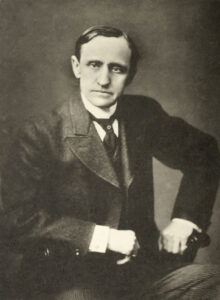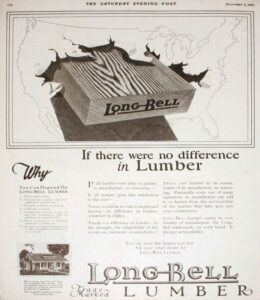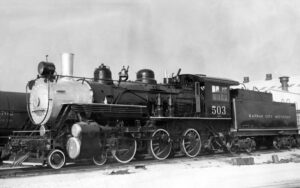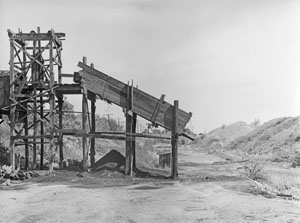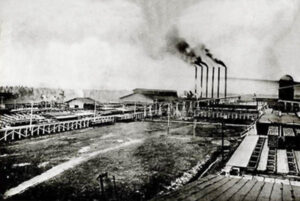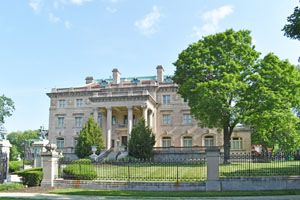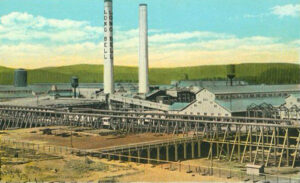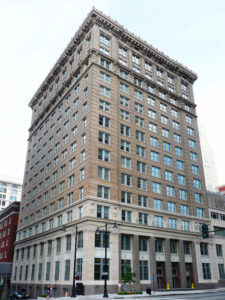Robert Alexander Long was a lumber baron, developer, investor, newspaper owner, and philanthropist. He lived most of his life in Kansas City, Missouri, and founded Longview, Washington, and Longville, Louisiana.
Robert Long was born on December 17, 1850, in Shelbyville, Kentucky, to Samuel M. and Margaret Kinkead White Long. He was one of nine children that grew up on his father’s farm.
He was educated in the common schools of Shelby County and spent 15 months in a school for boys at Shelbyville. Afterward, he worked as a clerk in a local store. When he was 22, he moved to Columbus, Kansas, in 1873, where his uncle, C. J. White, was a banker.
In 1874, Robert met 19-year-old Martha Ellen Wilson, who became a school teacher. A year later, the couple married on December 16, 1876. The couple first had a son who lived only a few weeks, but later had two daughters, Sally America, born in 1879, and Loula in 1881.
Robert then started a hay bale company with his cousin Robert White and a friend, Victor B. Bell. Though the hay venture failed, the three were able to sell the lumber from the hay sheds. Seeing that lumber was in demand, they ordered more lumber. On April 30, 1875, a carload of lumber was unloaded in Columbus in Cherokee County, Kansas. At that time, the firm’s senior member, Robert Long, was 24r years old, and his partners had not yet reached their majority. Long served as yard manager, bookkeeper, and general utility man. He had only the most casual acquaintance with the lumber business. Though the company owners had neither surplus capital nor bank accounts, Victor Bell’s father was the Kansas City Savings Bank president, and Robert White’s father was its cashier. Thus, the bank gave them the best recommendations and, when cash was required, loaned it to them on an open account.
The Long’s first home in Columbus was a small three-room cottage with his lumber yard only a short distance away on the same piece of ground. Later they built a more prominent and commanding house in Columbus, where they remained residents for over 16 years.
In the first year, the firm at Columbus earned only $800. In the second year, its profits were $2,000. By that time, the business was flourishing enough to justify the establishment of a branch yard. In 1877 the youngest partner, Robert White, died, and the two remaining partners bought out his share. Several different yards were established over Southern Kansas in the next six to eight years.
In 1884 the company was incorporated with a capital of $300,000. Every year saw a notable increase in the establishment of new yards and the general enlargement of the scope of operations. Whereas Mr. Long at Columbus forty years ago was content to sell lumber a few hundred feet at a time, the business of the present corporation in its retail department alone sells millions of feet of rough and finished lumber and millwork and vast quantities of lime, cement, coal, and other products.
In 1887, Robert A. Long and Victor Bell formed the Long-Bell Lumber Company in Columbus, Kansas. That year, his brother-in-law Samuel H. Wilson joined the company. In 1889 a wholesale department was added, and the same year, Samuel Wilson took over the retail department, a position he held until his death on October 20, 1903.
Long was an early investor in the Kansas City Southern Railroad, a source of transportation for his raw material and products. Founded in 1887, the railroad is still in operation today.
At some point, Long bought 1,520 acres and developed a profitable coal mine with two shafts in nearby Stone City northwest of Columbus.
In 1891, the capital stock was increased to $500,000. That year, Long moved his family to Kansas City, where they lived in a spacious Queen Anne-style house on Independence Avenue, one of the city’s most upscale addresses.
When the railroad entered Louisiana, Robert Long was among the earliest to set up shop. In 1900, the Long-Bell Lumber Company organized the King-Ryder Lumber Company at Bon Ami, Louisiana. After purchasing land in many parts of the state, the company began lumber harvesting to supply the needs of the large lumber company. By that year, Kansas City was shipping 4,000 railcars of finished lumber annually.
The Long-Bell Lumber Company then became the parent organization of a vast business system. Besides the Long-Bell Lumber Company, nine allied corporations were engaged in lumber manufacture, and several other corporations for conducting various business activities. The organization now owns immense land holdings in Louisiana, Texas, and Arkansas. The ten sawmill plants had an annual capacity of 500,000,000 feet.
In 1902 the retail yards of the Long-Bell Lumber Company numbered 50, with a working force of 1,600 men, and its manufacturing plants were all furnished with modern equipment. Important branches established at St. Louis, Texarkana, and Tacoma, Washington, and a capital stock of $1,250,000 attested to the success of the man behind the executive desk.
In 1903, Long-Bell organized the Hudson River Lumber Company in DeRidder, Louisiana, and built a sprawling mill across the tracks from Washington Street. At that time, the Kansas City Southern Railroad and the Atchison, Topeka & Santa Fe Railroad ran through Deridder.
By 1904 the mill in Bon Ami, Louisiana, was producing 300,000 board feet of lumber daily, which made it the largest in the area at the time.
On March 16, 1906, the Long-Bell Company bought out two mills of the Bradley-Ramsey Lumber Company in Lake Charles, Louisiana. This included 105,000 acres and 36 miles of the Lake Charles and Leesville Railroad, renamed the Lake Charles and Northern Railroad. This purchase included seven locomotives,120 log cars, and 59 miles of tracks. The new rail formed part of the Atlantic System of the Southern Pacific Company. In October 1906, a new location was cleared along the route for the Longville Long Leaf Lumber Company and town. The company built the three-story, 60-room Southern Hotel, 163 cottages for workers, a large commissary with $30,000 worth of supplies, an elementary and high school, a complete machine shop, a roundhouse, a car repair shop, and a blacksmith shop. There was also a two-story fire department building, providing around-the-clock service, that started with a horse-drawn wagon, then a fire truck, the First National Bank, a barbershop, and the Dixie Theater.
The Long-Bell Lumber Company was the world’s largest lumber company by then.
In 1907 the 14-story R.A. Long Building, a Beaux-Arts skyscraper in downtown Kansas City was built at 928 Grand Avenue for $1,250,000. It is listed in the National Register of Historic Places today.
The same year, the Longs began building an estate that reflected their local and national prominence. Overlooking the picturesque North Terrace Park, the 72-room, stone-faced mansion and related buildings filled an entire city block. The three-acre Long estate was sited on a hill 280 feet above the Missouri River, commanding a view with few rivals in Kansas City. In addition to the primary residence, the estate included a carriage house and stable, gate lodge, greenhouse, and colonnaded pergola. Long’s passion for horses was illustrated at the Gladstone mansion by the $80,000 stable, designed to accommodate ten horses and five grooms. When it was completed in 1911, the Longs named it Corinthian Hall. The French Renaissance mansion at 3218 Gladstone Boulevard was Kansas City’s first million-dollar home. The mansion is listed on the National Register of Historic Places today and serves as the Kansas City Museum.
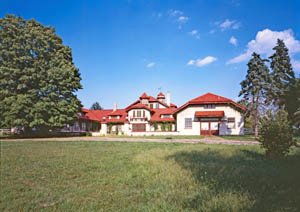
The Show Horse Barn at Longview Farm became the Longview Elementary School. Photo by the Historic American Buildings Survey.
In about 1913, Long-Bell acquired the Ludington Lumber Company and transferred 3000 acres to shore up its uncut lumber reserve. When the mill burned in 1920, an estimated 2500 residents lived in Longville, Louisiana. With the uncut lumber reserve dwindling, the mill was not rebuilt, so the town began to disappear. The planer was converted to a hardwood flooring mill, which was moved to DeRidder, Louisiana, in 1927 when all operations at Longville ceased.
Robert built Longview Farm in 1913-1914, in eastern Jackson County, on the outskirts of Kansas City. The 2,000-acre farm had 42 buildings, 250 acres of clipped lawns, extensive flower beds, four greenhouses, dairy barns, and a stately 22,000-square-foot mansion. Portions of the farm are now sites of Longview College, Longview Lake, and the New Longview neighborhood in Lees Summit, Missouri. The farm was listed on the National Register of Historic Places on October 24, 1985.
In 1923 Robert Long founded the city of Longview, Washington, a “planned city” built near two of Long-Bell’s lumber mills. He donated funds for the city’s public library, first high school, train station, YMCA hall, and Hotel Monticello. The mills were advertised as the largest in the world. A newspaper was also established, with the first issue of Longview News coming off the press and published on January 27, 1923. Long was the principal stockholder until his death on March 15, 1934, and it was then held in a family trust until 1947.
Long was a driving force behind the creation of Kansas City’s Liberty Memorial, a World War I museum and monument. He was the president of the Liberty Memorial Association and a significant contributor. In less than a year, the organization collected $2,500,000. The monument was dedicated on November 11, 1926.
Long died on March 15, 1934, at age 83, and was buried at the Forest Hill Cemetery in Kansas City. That year, the Long-Bell Lumber Company filed for bankruptcy, then filed a reorganization plan in the Kansas City federal court in 1935 after Long’s death.
In August 1946, a bronze bust of Long was placed in the renamed R. A. Long Park in Longview, Washington.
In 1956, International Paper Company purchased all the remaining holdings of the Long-Bell Lumber Company and renamed it IP-Long-Bell. With the lumber depleted and the mill antiquated, IP-Bell ceased operations in 1960, and the mills were dismantled and sold.
“Every big businessman should write a paper or make a speech at least twice a year on some live subject, not necessarily connected with his business, that would require investigation. Investigation means more knowledge, and knowledge is an asset.”
— Robert A. Long
©Kathy Alexander/Legends of America, June 2023.
Also See:
Historical People of Kansas City
Sources:
Case, Theodore S.; History of Kansas City Missouri, D. Mason & Co.; Syracuse, New York, 1888.
Connelley, William E.; A Standard History of Kansas and Kansans, Lewis, Chicago, 1918.
KC Studio
Pendergast KC
Wikipedia

